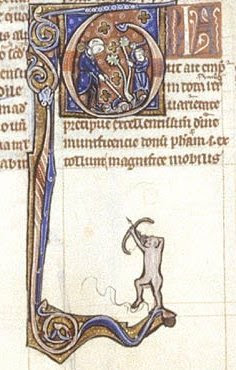Got Medieval got linked by BoingBoing!* One of my longheld dreams has finally been fulfilled.
Now, how to parlay this sudden exposure into fame and fortune? How can I keep all these new eyeballs from coming, glancing at my post on fanfic, and then scurrying off to the rest of teh intertubes or the blagosphere** never to return? What can I offer them to bring them back?
Let’s see. They’ve already seen the Medieval Safe Sex Flowchart, and there’s nothing medieval I can make out of a used Altoids tin or a NES controller. To make matters worse, among geeks, medieval-style fantasy is slowly losing market share to steampunk, so posting about Tolkien is flat out. And as far as I’m aware, the European Middle Ages’ reserves of hobos, robots, ninjas, and zombies were critically low. That leaves me with only two BoingBoing baits: pirates and monkeys. Since I’ve already done some groundbreaking research on the phenomenon of monkeys and their butt-trumpets (and their love of urinalysis) I think this line of attack is the most promising.
Fortunately, the Middle Ages was obsessed with monkeys. Nothing spices up the margins of your boring old psalter like a picture of a cute monkey doing something really odd, like riding a stork who has a demon’s head for a butt:
As I’ve said before, Lancelot Link, Secret Chimp, was a very medieval show. Medieval artists and audiences were quite fond of the old sight gag of having a monkey do something typically human, like roasting chickens…

or riding around like a knight…

or fighting each other while on stilts…

or being disciplined by the head monkey at monkey school…

or serving as disapproving art critics…

Sometimes marginal monkeys got jealous, started resenting their position in the marginalia, and even launched attacks against the simple farm folk in nearby historiated initials:
 As with most things medieval, there’s a bit of theology and a bit of etymology behind all this love of monkey business. As I mentioned long, long ago when I blogged about the medieval beaver, the etymology of an animal’s name was thought to capture something essential about its nature. In the case of the beaver (Latin: castor) , this was its ability to hurl its own testicles (castoreum) at wouldbe hunters. Thus, a typical bestiary entry for the monkey*** reads,
As with most things medieval, there’s a bit of theology and a bit of etymology behind all this love of monkey business. As I mentioned long, long ago when I blogged about the medieval beaver, the etymology of an animal’s name was thought to capture something essential about its nature. In the case of the beaver (Latin: castor) , this was its ability to hurl its own testicles (castoreum) at wouldbe hunters. Thus, a typical bestiary entry for the monkey*** reads,
Apes are called Simia in Latin [c.f. modern “simian”], because they are thought to be so similar (similius) in reasoning to humans.
Because of its closeness to its human brethren, the ape/monkey becomes something of an important test-case for defining the boundaries of medieval “humanity.” Metaphorically, monkeys are the animals that dance along the border between human and not-human; spatially, they inhabit the borders of manuscripts, where they play at being human.****
The Devil himself is often depicted as an ape, because he is near to man, and because of an even more obscure feature of medieval monkeykind. Here, again from the Aberdeen bestiary:
When a mother ape bears twins, she loves one and despises the other. If it ever happens that she is pursued by hunters, she carries the one she loves before her in her arms and the one she detests on her shoulders. But when she is tired of going upright, she deliberately drops the one she loves and reluctantly carries the one she hates.
This favoritism is evidenced at least as far back to at least Aesop, but medieval theologians never met a beast fable they couldn’t allegorize. Phillipe de Thaon’s bestiary (which I learned about at this other awesome bestiary entry) notes that the ape represents the Devil, because the Devil mocks sinners, carrying them before him to Hell, while the righteous are kept on his back (and presumably, left behind when he shows his true animal nature and drops to all fours).
So, there you go, BoingBoing–a handful of medieval monkeys in thanks for sextupling my bloghits today.
—
*Non-geek blog-reading medievalists (if such a creature exists) may be puzzled. BoingBoing and Slashdot, while catering to different subsets of geekery, are essentially the two sites of record for geek culture on the web. Getting linked by them is like being published by Speculum, Exemplaria, or JMEMS, which I’ve just learned form the holy trinity of medievalist publications. Geeks only have the two.
**See, BoingBoingers, I’m hep to your slang! 23-Skidoo and gadzooks, or something, squares.
***Alert pedants will protest, “Hey, monkeys and apes aren’t the same thing!” To them I say, according to medieval bestiaries, they were. There were thought to be five to seven (depending on the bestiary) major types of apes, of which monkeys were one type, those that had long tails. Strangely enough, satyrs were another type, and sphinxes yet another.
****For more on this, see the opening pages of chapter one of James R. Simpson’s Animal Body, Literary Corpus: The Old French Roman de Renart.

